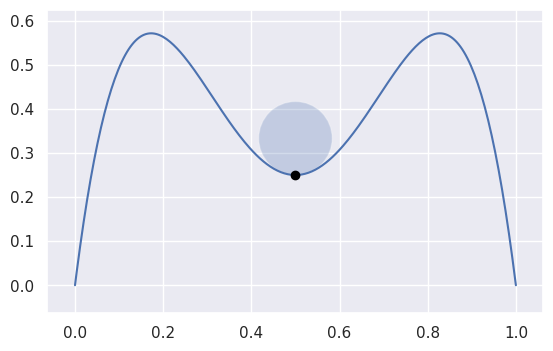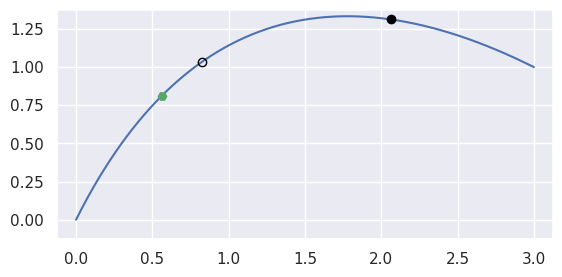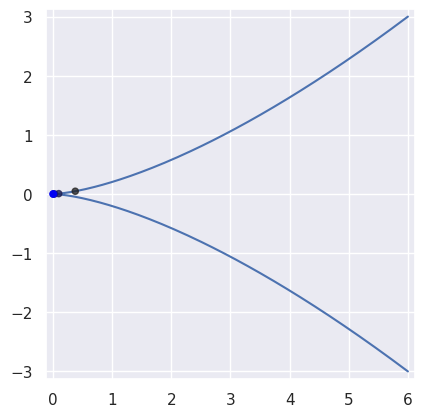bezier.hazmat.curve_helpers module¶
Pure Python implementations of helper methods for Bézier curves.
- bezier.hazmat.curve_helpers.make_subdivision_matrices(degree)¶
Make the matrix used to subdivide a curve.
Note
This is a helper for
subdivide_nodes(). It does not have a Fortran speedup because it is only used by a function which has a Fortran speedup.- Parameters:
degree (int) – The degree of the curve.
- Returns:
The matrices used to convert the nodes into left and right nodes, respectively.
- Return type:
- bezier.hazmat.curve_helpers.subdivide_nodes(nodes)¶
Subdivide a curve into two sub-curves.
Does so by taking the unit interval (i.e. the domain of the curve) and splitting it into two sub-intervals by splitting down the middle.
Note
There is also a Fortran implementation of this function, which will be used if it can be built.
- Parameters:
nodes (numpy.ndarray) – The nodes defining a Bézier curve.
- Returns:
The nodes for the two sub-curves.
- Return type:
- bezier.hazmat.curve_helpers.evaluate_multi(nodes, s_vals)¶
Computes multiple points along a curve.
Note
There is also a Fortran implementation of this function, which will be used if it can be built.
- Parameters:
nodes (numpy.ndarray) – The nodes defining a curve.
s_vals (numpy.ndarray) – Parameters along the curve (as a 1D array).
- Returns:
The evaluated points on the curve as a two dimensional NumPy array, with the columns corresponding to each
svalue and the rows to the dimension.- Return type:
- bezier.hazmat.curve_helpers.evaluate_multi_vs(nodes, lambda1, lambda2)¶
Evaluates a Bézier type-function.
Of the form
\[B(\lambda_1, \lambda_2) = \sum_j \binom{n}{j} \lambda_1^{n - j} \lambda_2^j \cdot v_j\]for some set of vectors \(v_j\) given by
nodes.Does so via a modified Horner’s method (the VS Algorithm) for each pair of values in
lambda1andlambda2.\[\begin{split}\begin{align*} w_0 &= \lambda_1 v_0 \\ w_j &= \lambda_1 \left[w_{j - 1} + \binom{n}{j} \lambda_2^j v_j\right] \\ w_n &= w_{n - 1} + \lambda_2^n v_n \\ B(\lambda_1, \lambda_2) &= w_n \end{align*}\end{split}\]Additionally, binomial coefficients are computed by utilizing the fact that \(\binom{n}{j} = \binom{n}{j - 1} \frac{n - j + 1}{j}\).
- Parameters:
nodes (numpy.ndarray) – The nodes defining a curve.
lambda1 (numpy.ndarray) – Parameters along the curve (as a 1D array).
lambda2 (numpy.ndarray) – Parameters along the curve (as a 1D array). Typically we have
lambda1 + lambda2 == 1.
- Returns:
The evaluated points as a two dimensional NumPy array, with the columns corresponding to each pair of parameter values and the rows to the dimension.
- Return type:
- bezier.hazmat.curve_helpers.evaluate_multi_de_casteljau(nodes, lambda1, lambda2)¶
Evaluates a Bézier type-function.
Of the form
\[B(\lambda_1, \lambda_2) = \sum_j \binom{n}{j} \lambda_1^{n - j} \lambda_2^j \cdot v_j\]for some set of vectors \(v_j\) given by
nodes.Does so via the de Castljau algorithm:
\[\begin{split}\begin{align*} v_j^{(n)} &= v_j \\ v_j^{(k)} &= \lambda_1 \cdot v_j^{(k + 1)} + \lambda_2 \cdot v_{j + 1}^{(k + 1)} \\ B(\lambda_1, \lambda_2) &= v_0^{(0)} \end{align*}\end{split}\]- Parameters:
nodes (numpy.ndarray) – The nodes defining a curve.
lambda1 (numpy.ndarray) – Parameters along the curve (as a 1D array).
lambda2 (numpy.ndarray) – Parameters along the curve (as a 1D array). Typically we have
lambda1 + lambda2 == 1.
- Returns:
The evaluated points as a two dimensional NumPy array, with the columns corresponding to each pair of parameter values and the rows to the dimension.
- Return type:
- bezier.hazmat.curve_helpers.evaluate_multi_barycentric(nodes, lambda1, lambda2)¶
Evaluates a Bézier type-function.
Of the form
\[B(\lambda_1, \lambda_2) = \sum_j \binom{n}{j} \lambda_1^{n - j} \lambda_2^j \cdot v_j\]for some set of vectors \(v_j\) given by
nodes. This uses the more efficientevaluate_multi_vs()until degree 55, at which point \(\binom{55}{26}\) and other coefficients cannot be computed exactly. For degree 55 and higher, the classical de Casteljau algorithm will be used viaevaluate_multi_de_casteljau().Note
There is also a Fortran implementation of this function, which will be used if it can be built.
- Parameters:
nodes (numpy.ndarray) – The nodes defining a curve.
lambda1 (numpy.ndarray) – Parameters along the curve (as a 1D array).
lambda2 (numpy.ndarray) – Parameters along the curve (as a 1D array). Typically we have
lambda1 + lambda2 == 1.
- Returns:
The evaluated points as a two dimensional NumPy array, with the columns corresponding to each pair of parameter values and the rows to the dimension.
- Return type:
- bezier.hazmat.curve_helpers.vec_size(nodes, s_val)¶
Compute \(\|B(s)\|_2\).
Note
This is a helper for
compute_length()and does not have a Fortran speedup.Intended to be used with
functools.partial()to fill in the value ofnodesand create a callable that only acceptss_val.- Parameters:
nodes (numpy.ndarray) – The nodes defining a curve.
s_val (float) – Parameter to compute \(B(s)\).
- Returns:
The norm of \(B(s)\).
- Return type:
- bezier.hazmat.curve_helpers.compute_length(nodes)¶
Approximately compute the length of a curve.
If
degreeis \(n\), then the Hodograph curve \(B'(s)\) is degree \(d = n - 1\). Using this curve, we approximate the integral:\[\int_{B\left(\left[0, 1\right]\right)} 1 \, d\mathbf{x} = \int_0^1 \left\lVert B'(s) \right\rVert_2 \, ds\]using QUADPACK (via SciPy).
Note
There is also a Fortran implementation of this function, which will be used if it can be built.
- Parameters:
nodes (numpy.ndarray) – The nodes defining a curve.
- Returns:
The length of the curve.
- Return type:
- Raises:
ValueError – If
nodeshas zero columns.
- bezier.hazmat.curve_helpers.elevate_nodes(nodes)¶
Degree-elevate a Bézier curve.
Does this by converting the current nodes \(v_0, \ldots, v_n\) to new nodes \(w_0, \ldots, w_{n + 1}\) where
\[\begin{split}\begin{align*} w_0 &= v_0 \\ w_j &= \frac{j}{n + 1} v_{j - 1} + \frac{n + 1 - j}{n + 1} v_j \\ w_{n + 1} &= v_n \end{align*}\end{split}\]Note
There is also a Fortran implementation of this function, which will be used if it can be built.
- Parameters:
nodes (numpy.ndarray) – The nodes defining a curve.
- Returns:
The nodes of the degree-elevated curve.
- Return type:
- bezier.hazmat.curve_helpers.de_casteljau_one_round(nodes, lambda1, lambda2)¶
Perform one round of de Casteljau’s algorithm.
Note
This is a helper for
specialize_curve(). It does not have a Fortran speedup because it is only used by a function which has a Fortran speedup.The weights are assumed to sum to one.
- Parameters:
nodes (numpy.ndarray) – Control points for a curve.
lambda1 (float) – First barycentric weight on interval.
lambda2 (float) – Second barycentric weight on interval.
- Returns:
The nodes for a “blended” curve one degree lower.
- Return type:
- bezier.hazmat.curve_helpers.specialize_curve(nodes, start, end)¶
Specialize a curve to a re-parameterization
Note
This assumes the curve is degree 1 or greater but doesn’t check.
Note
There is also a Fortran implementation of this function, which will be used if it can be built.
- Parameters:
nodes (numpy.ndarray) – Control points for a curve.
start (float) – The start point of the interval we are specializing to.
end (float) – The end point of the interval we are specializing to.
- Returns:
The control points for the specialized curve.
- Return type:
- bezier.hazmat.curve_helpers.evaluate_hodograph(s, nodes)¶
Evaluate the Hodograph curve at a point \(s\).
The Hodograph (first derivative) of a Bézier curve degree \(d = n - 1\) and is given by
\[B'(s) = n \sum_{j = 0}^{d} \binom{d}{j} s^j (1 - s)^{d - j} \cdot \Delta v_j\]where each forward difference is given by \(\Delta v_j = v_{j + 1} - v_j\).
Note
There is also a Fortran implementation of this function, which will be used if it can be built.
- Parameters:
nodes (numpy.ndarray) – The nodes of a curve.
s (float) – A parameter along the curve at which the Hodograph is to be evaluated.
- Returns:
The point on the Hodograph curve (as a two dimensional NumPy array with a single row).
- Return type:
- bezier.hazmat.curve_helpers.get_curvature(nodes, tangent_vec, s)¶
Compute the signed curvature of a curve at \(s\).
Computed via
\[\frac{B'(s) \times B''(s)}{\left\lVert B'(s) \right\rVert_2^3}\]
>>> import numpy as np >>> nodes = np.asfortranarray([ ... [1.0, 0.75, 0.5, 0.25, 0.0], ... [0.0, 2.0 , -2.0, 2.0 , 0.0], ... ]) >>> s = 0.5 >>> tangent_vec = evaluate_hodograph(s, nodes) >>> tangent_vec array([[-1.], [ 0.]]) >>> curvature = get_curvature(nodes, tangent_vec, s) >>> curvature -12.0
Note
There is also a Fortran implementation of this function, which will be used if it can be built.
- Parameters:
nodes (numpy.ndarray) – The nodes of a curve.
tangent_vec (numpy.ndarray) – The already computed value of \(B'(s)\)
s (float) – The parameter value along the curve.
- Returns:
The signed curvature.
- Return type:
- bezier.hazmat.curve_helpers.newton_refine(nodes, point, s)¶
Refine a solution to \(B(s) = p\) using Newton’s method.
Computes updates via
\[\mathbf{0} \approx \left(B\left(s_{\ast}\right) - p\right) + B'\left(s_{\ast}\right) \Delta s\]For example, consider the curve
\[\begin{split}B(s) = \left[\begin{array}{c} 0 \\ 0 \end{array}\right] (1 - s)^2 + \left[\begin{array}{c} 1 \\ 2 \end{array}\right] 2 (1 - s) s + \left[\begin{array}{c} 3 \\ 1 \end{array}\right] s^2\end{split}\]and the point \(B\left(\frac{1}{4}\right) = \frac{1}{16} \left[\begin{array}{c} 9 \\ 13 \end{array}\right]\).
Starting from the wrong point \(s = \frac{3}{4}\), we have
\[\begin{split}\begin{align*} p - B\left(\frac{1}{2}\right) &= -\frac{1}{2} \left[\begin{array}{c} 3 \\ 1 \end{array}\right] \\ B'\left(\frac{1}{2}\right) &= \frac{1}{2} \left[\begin{array}{c} 7 \\ -1 \end{array}\right] \\ \Longrightarrow \frac{1}{4} \left[\begin{array}{c c} 7 & -1 \end{array}\right] \left[\begin{array}{c} 7 \\ -1 \end{array}\right] \Delta s &= -\frac{1}{4} \left[\begin{array}{c c} 7 & -1 \end{array}\right] \left[\begin{array}{c} 3 \\ 1 \end{array}\right] \\ \Longrightarrow \Delta s &= -\frac{2}{5} \end{align*}\end{split}\]
>>> import bezier >>> nodes = np.asfortranarray([ ... [0.0, 1.0, 3.0], ... [0.0, 2.0, 1.0], ... ]) >>> curve = bezier.Curve(nodes, degree=2) >>> point = curve.evaluate(0.25) >>> point array([[0.5625], [0.8125]]) >>> s = 0.75 >>> new_s = newton_refine(nodes, point, s) >>> 5 * (new_s - s) -2.0
On curves that are not “valid” (i.e. \(B(s)\) is not injective with non-zero gradient), Newton’s method may break down and converge linearly:

>>> nodes = np.asfortranarray([ ... [ 6.0, -2.0, -2.0, 6.0], ... [-3.0, 3.0, -3.0, 3.0], ... ]) >>> curve = bezier.Curve(nodes, degree=3) >>> expected = 0.5 >>> point = curve.evaluate(expected) >>> point array([[0.], [0.]]) >>> s_vals = [0.625, None, None, None, None, None] >>> np.log2(abs(expected - s_vals[0])) -3.0 >>> s_vals[1] = newton_refine(nodes, point, s_vals[0]) >>> np.log2(abs(expected - s_vals[1])) -3.983... >>> s_vals[2] = newton_refine(nodes, point, s_vals[1]) >>> np.log2(abs(expected - s_vals[2])) -4.979... >>> s_vals[3] = newton_refine(nodes, point, s_vals[2]) >>> np.log2(abs(expected - s_vals[3])) -5.978... >>> s_vals[4] = newton_refine(nodes, point, s_vals[3]) >>> np.log2(abs(expected - s_vals[4])) -6.978... >>> s_vals[5] = newton_refine(nodes, point, s_vals[4]) >>> np.log2(abs(expected - s_vals[5])) -7.978...
Due to round-off, the Newton process terminates with an error that is not close to machine precision \(\varepsilon\) when \(\Delta s = 0\).
>>> s_vals = [0.625] >>> new_s = newton_refine(nodes, point, s_vals[-1]) >>> while new_s not in s_vals: ... s_vals.append(new_s) ... new_s = newton_refine(nodes, point, s_vals[-1]) ... >>> terminal_s = s_vals[-1] >>> terminal_s == newton_refine(nodes, point, terminal_s) True >>> 2.0**(-31) <= abs(terminal_s - 0.5) <= 2.0**(-28) True
Due to round-off near the cusp, the final error resembles \(\sqrt{\varepsilon}\) rather than machine precision as expected.
Note
There is also a Fortran implementation of this function, which will be used if it can be built.
- Parameters:
nodes (numpy.ndarray) – The nodes defining a Bézier curve.
point (numpy.ndarray) – A point on the curve.
s (float) – An “almost” solution to \(B(s) = p\).
- Returns:
The updated value \(s + \Delta s\).
- Return type:
- bezier.hazmat.curve_helpers.locate_point(nodes, point)¶
Locate a point on a curve.
Does so by recursively subdividing the curve and rejecting sub-curves with bounding boxes that don’t contain the point. After the sub-curves are sufficiently small, uses Newton’s method to zoom in on the parameter value.
Note
This assumes, but does not check, that
pointisD x 1, whereDis the dimension thatcurveis in.Note
There is also a Fortran implementation of this function, which will be used if it can be built.
- Parameters:
nodes (numpy.ndarray) – The nodes defining a Bézier curve.
point (numpy.ndarray) – The point to locate.
- Returns:
The parameter value (\(s\)) corresponding to
pointorNoneif the point is not on thecurve.- Return type:
- Raises:
ValueError – If the standard deviation of the remaining start / end parameters among the subdivided intervals exceeds a given threshold (e.g. \(2^{-20}\)).
- bezier.hazmat.curve_helpers.reduce_pseudo_inverse(nodes)¶
Performs degree-reduction for a Bézier curve.
Does so by using the pseudo-inverse of the degree elevation operator (which is overdetermined).
Note
There is also a Fortran implementation of this function, which will be used if it can be built.
- Parameters:
nodes (numpy.ndarray) – The nodes in the curve.
- Returns:
The reduced nodes.
- Return type:
- Raises:
UnsupportedDegree – If the degree is not 1, 2, 3 or 4.
- bezier.hazmat.curve_helpers.projection_error(nodes, projected)¶
Compute the error between
nodesand the projected nodes.Note
This is a helper for
maybe_reduce(), which is in turn a helper forfull_reduce(). Hence there is no corresponding Fortran speedup.For now, just compute the relative error in the Frobenius norm. But, we may wish to consider the error per row / point instead.
- Parameters:
nodes (numpy.ndarray) – Nodes in a curve.
projected (numpy.ndarray) – The
nodesprojected into the space of degree-elevated nodes.
- Returns:
The relative error.
- Return type:
- bezier.hazmat.curve_helpers.maybe_reduce(nodes)¶
Reduce nodes in a curve if they are degree-elevated.
Note
This is a helper for
full_reduce(). Hence there is no corresponding Fortran speedup.We check if the nodes are degree-elevated by projecting onto the space of degree-elevated curves of the same degree, then comparing to the projection. We form the projection by taking the corresponding (right) elevation matrix \(E\) (from one degree lower) and forming \(E^T \left(E E^T\right)^{-1} E\).
- Parameters:
nodes (numpy.ndarray) – The nodes in the curve.
- Returns:
Pair of values. The first indicates if the
nodeswere reduced. The second is the resulting nodes, either the reduced ones or the original passed in.- Return type:
- Raises:
UnsupportedDegree – If the curve is degree 5 or higher.
- bezier.hazmat.curve_helpers.full_reduce(nodes)¶
Apply degree reduction to
nodesuntil it can no longer be reduced.Note
There is also a Fortran implementation of this function, which will be used if it can be built.
- Parameters:
nodes (numpy.ndarray) – The nodes in the curve.
- Returns:
The fully degree-reduced nodes.
- Return type:
- bezier.hazmat.curve_helpers.discrete_turning_angle(nodes)¶
Determine the absolute sum of Bézier node angles.
Note
This assumes, but does not check, that
nodesis2 x N.For the set of vectors \(v_j\) given by
nodes, the discrete angles \(\theta_j\) at each internal node is given by\[\left(v_{j} - v_{j - 1}\right) \cdot \left(v_{j + 1} - v_{j}\right) = \| v_{j} - v_{j - 1} \|_2 \| v_{j + 1} - v_{j} \|_2 \cos \theta_j\]and the discrete turning angle is \(\sum_{j} \left|\theta_j\right|\). This approximates the exact turning angle
\[\int_0^1 \left|\theta'(s)\right| \, ds.\]This is done by considering how the angle of \(B'(s) = \left[x'(s), y'(s)\right]^T\) changes in small intervals in the parameter space; where the angle is \(\theta(s) = \arctan(y'(s) / x'(s))\). Computing \(\theta(s + ds) - \theta(s)\) as \(ds \longrightarrow 0\) leaves us with the signed angle change
\[\theta'(s) = \frac{y''(s) x'(s) - x''(s) y'(s)}{x'(s)^2 + y'(s)^2}.\]- Parameters:
nodes (numpy.ndarray) – The nodes in the curve.
- Returns:
The (discrete) turning angle.
- Return type: